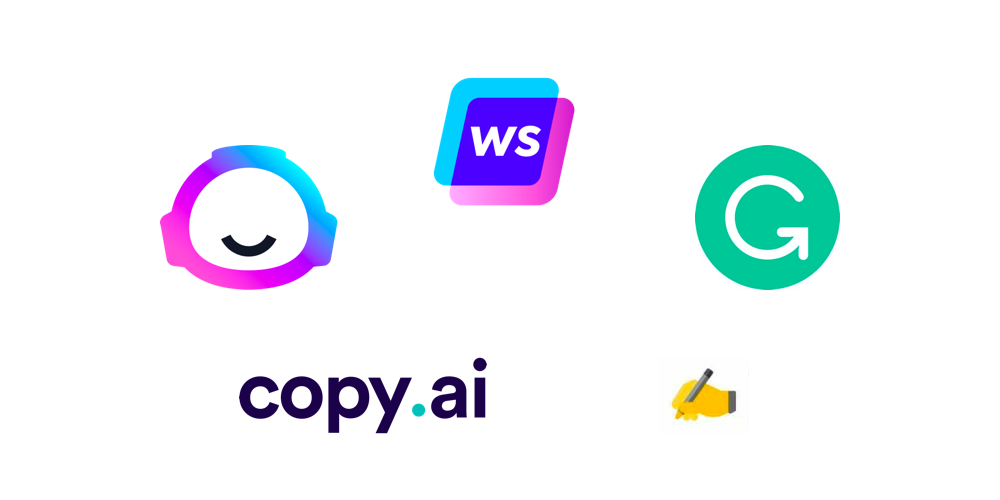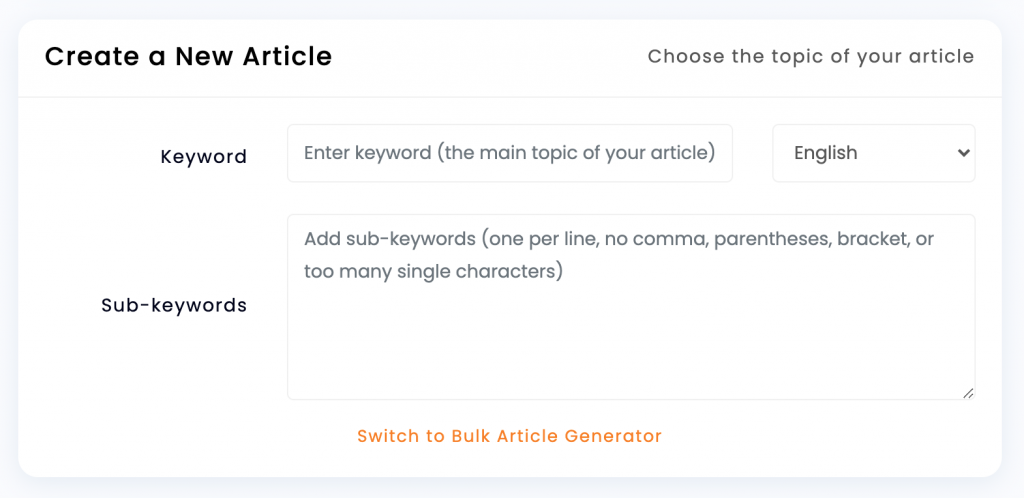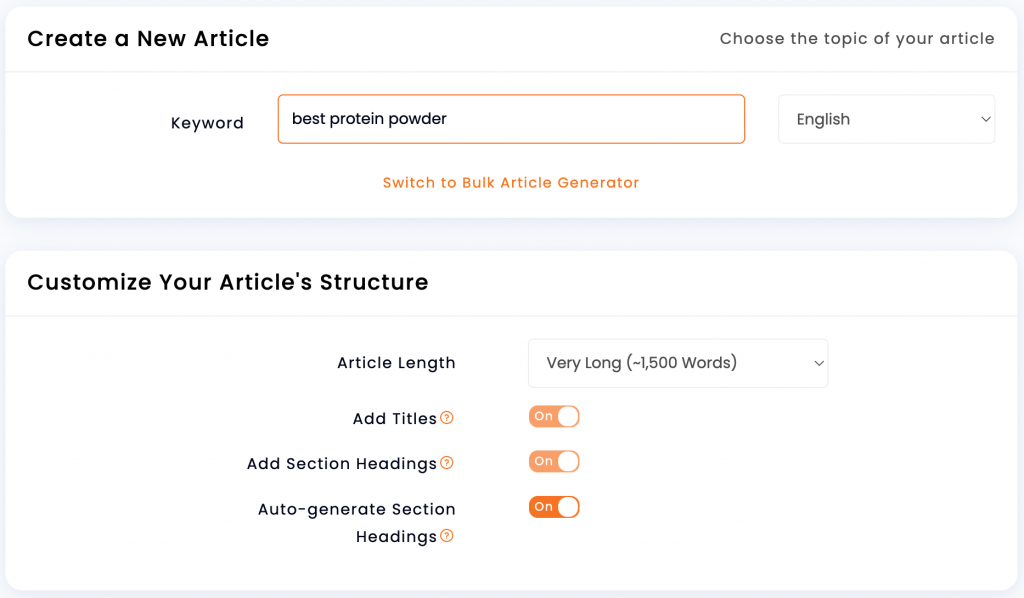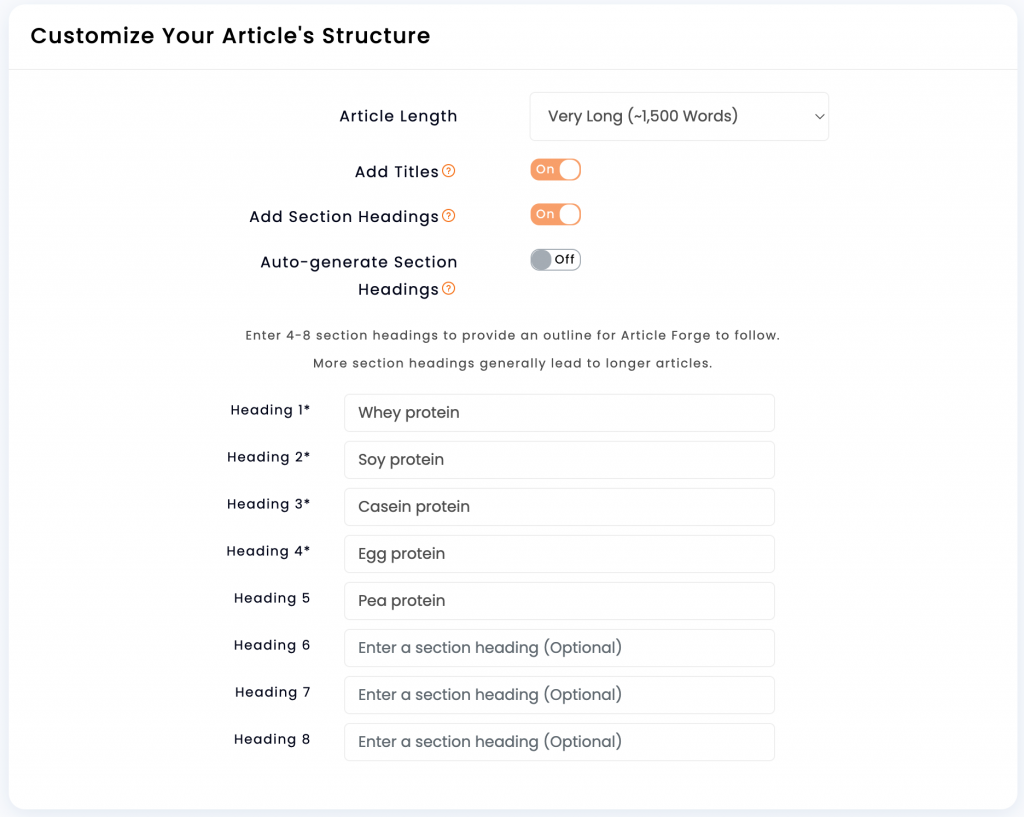Artificial intelligence and machine learning are making huge waves across the digital marketing sector, and the content writing industry hasn’t been ignored. There are a lot of new AI text generators out there right now - Article Forge, Jasper (formerly Jarvis), and Copy.ai are just a few.
They are similar in that they use deep learning AI to generate text, but it’s essential to be aware of the differences. After all, “generating text” is an extremely broad concept that can have completely different applications and advantages. In short, these tools have completely different workflows for generating content.
A massive distinction between Article Forge and other AI writing tools is that Article Forge is truly a writer that delivers full pieces of content, while other tools like Jasper and Copy.ai are AI-powered writing assistants that provide a platform to help you write.
This article discusses the fundamental differences between an AI writer and an AI writing assistant, illustrating the different use cases and the overall automation potential that Article Forge has as one of the only true AI writers.
Contents:
- What is an AI writing assistant?
- What is an AI writer?
- Considerations to make when using any AI text generation solution
- Automation Potential of AI Writers
- An AI writer is the ideal tool for content managers
- Article Forge’s Unique Position
- Why You Should Create Content With an AI Writer
- How To Create Content With Article Forge’s AI Writer
What is an AI writing assistant?
The vast majority of AI writing tools on the market would be considered AI writing assistants. They assist humans in their writing but require constant involvement throughout the process.
One aspect is that users must continuously enter written information to interact with the tool. Jasper, for example, lists things like “sentence expander” and “blog post intro paragraph” as some of its primary use cases. This usage focuses on expanding or stylizing content that a human writes first. While Jasper also claims to have the ability to generate long-form content, the user is required to fill in prompts at every step along the way.

Another common task for AI writing assistants is generating short snippets of text based on a given sample. Copy.ai is known for its ability to create things like captions, “Blog Titles, Ideas, Outlines,” and a “Before-After-Bridge” for sales copy. Here again, the bulk of the actual writing that might go into these projects must be done by humans before the AI assistant comes into play.
Writing tools like Grammarly - and even the onboard grammar checker in Microsoft Word - are augmented by text generation AI. Still, their core purpose is to improve existing writing by suggesting edits for grammatical and stylistic issues.
There’s no doubt that these tools are handy, but AI and deep learning technology allow for so much more.
What is an AI writer?
Article Forge stands out from these other AI writing tools because its primary use case is to compose full, end-to-end long-form content - like articles and blog posts - from a single keyword input. This ability to create entire articles makes Article Forge a true AI content generator.

Beyond using AI to write articles, Article Forge has developed additional deep learning models and algorithms to help it write largely factually accurate content with no human intervention. This ability further sets Article Forge apart from its peers and makes it one of the only examples of a true AI article writer.
Rather than walking through the entire writing process, the only human interaction required for Article Forge to return an entire article is an initial input of a focus keyword and, optionally, some sub-keywords.
Of course, the quality of the content an AI writer can generate depends partially on the given keywords and the complexity of the content that you hope to achieve. But the fact of the matter is that after one simple step, the AI article writer delivers an entire piece of content that you can do whatever you want with.
Considerations to make when using any AI text generation solution
Both AI writers and AI assistants have a few shortcomings that must be kept in mind. While AI is an exciting technology with a lot of potential, it is still relatively young and is constantly being improved.
Accuracy
For one, AI writing tools, in general, have difficulty fact checking the content they write. Both Copy.ai and Jasper have been known to create some comically inaccurate content, and Article Forge has historically had its fair share of mistakes, especially with very specific terms.
However, as mentioned above, Article Forge is actively working on solving this issue and its 3.0 update was centered around being able to write largely factually accurate content. It still does slip up from time to time, but Article Forge’s fact checking ability is one of a kind and is being continuously researched and updated.
Understanding a brand’s strategy
AI content generators also have difficulty identifying and implementing a brand’s strategy and voice. While these AI content tools can write text that sounds natural and human, they cannot yet write text that encapsulates more abstract concepts like targeting a particular audience or framing information based on specific company guidelines.
Because the above weaknesses are present in any content generated by an AI, the most important consideration to make is the total time saved and the amount of human involvement required.
With Article Forge, you jump from keyword to full article in about a minute. While in contrast, Jasper and Copy.ai supply output along the way, but require you to do the bulk of the writing legwork to get to the same place.
Automation potential for AI writers
As long as your content strategy doesn’t require hyper-technical, or analytical thought-leadership pieces, Article Forge can fully automate the vast majority of your content production pipeline. On top of its ability to automatically generate entire articles, Article Forge also has many features that allow users to automate the publishing or deployment of those articles.
Article Forge has a built-in post scheduler and an integration with WordPress that lets you schedule recurring posts and deploy them straight to your WordPress blog without human intervention. It also has an API that allows web developers to integrate Article Forge directly into their development workflows.
AI writing assistants are undoubtedly valuable tools, but they don’t fundamentally disrupt the content production process in the way that an AI writer like Article Forge does.
An AI writer is the ideal tool for content managers
AI writers are best employed by content managers: marketing professionals who need to work with a lot of content at a time to meet their goals. Their time is best spent developing high-level talking points and sales themes while a writer - perhaps one powered by artificial intelligence - composes and publishes content based on those themes.
AI writing assistants are best used by those boots-on-the-ground writers. They are great for working out the nitty-gritty details of a piece of content if you are fine with writing the majority of your posts along the way. Their use is on a much smaller scale than AI article writers like Article Forge.
Article Forge’s unique position
Article Forge is one of the only true AI writers out there right now. Jasper, Copy.ai, and other AI writing assistants can generate short pieces like captions, headlines, snippets, and outlines. So, although AI writing assistants can help defeat writer’s block, they still require significant human involvement to create fully developed long-form pieces like articles.
With the right configuration, Article Forge can be used to create a fully automated end-to-end content production pipeline. It can act as a “writer” in the fullest sense, potentially replacing human writers completely. While AI writing assistants still have their uses, it is time for content managers to start seriously considering using an AI writer like Article Forge to take their content production to the next level.
Why You Should Create Content With an AI Writer
Creating content with an AI writer like Article Forge is incredibly simple. With just a single click, you can generate 1,500+ word articles. Not only will these articles be 100% unique, they will also be helpful, direct and optimized for SEO (Search Engine Optimization).
Traditionally, creating original content was the most time-consuming part of the content production process.
Previously, you would need to research, plan, and write your first drafts before you could even get to proofreading, editing, and optimizing your content. Even if you outsource the actual content creation, you still need to find, vet, hire, and manage your writers.
You would also have to take into account SEO considerations, and depending on how “good” your content is according to the 200+ Google ranking factors, you may or may not rank well.
There are millions of blog posts published each month, and the truth is your content will always be “hit or miss”.
So, yes. The fact is, you must create and publish a LOT of content frequently and consistently. As you know, this can either be highly time-consuming or very expensive. You need a solution, and Article Forge provides that.
Article Forge is a true AI writer that can generate entire articles with less than 15 seconds of work. This is simply the most sustainable and realistic way to fulfill your content needs and satisfy Google. We even ran a case study to see how Google treats Article Forge content and found that Article Forge content ranked just as well as content created by freelancers. And because Article Forge content is a lot cheaper and much less time-consuming to create, there is simply no reason not to be ranking with AI.
How To Create Content With Article Forge’s AI Writer
Now that you understand what an AI writer is and why Article Forge is unique, we will show you just how easy it is to produce content that ranks.
We will walk you through how to find keywords that will give you th best results, but if you’ve already done your keyword research, you can skip directly to the generation step.
Remember, performing solid keyword research allows you to dictate exactly how you want Article Forge to create your content. The following walkthrough is meant to be beginner-friendly to make sure everyone can create content that ranks.
Keyword Research
Keyword research is a critical part of the content creation process. Without performing keyword research, you are simply guessing what content you should be creating. Therefore implementing a strategy is essential.
Search Intent
When it comes to keywords, you first need to understand search intent. Search intent is exactly how it sounds, and it relates to the end user. An excellent way to think about search intent is by humanizing it and asking “what would I want to see if I performed this search”.
Suppose you searched for “best toys for difficult babies” this is a very specific search and the intent is clear. The user is looking for toys they can buy their baby to prevent tantrums. Now, if you want to create content and rank for this keyword… you have to give the user exactly what they want.
There are 4 types of search intent, but to generate content that will drive qualified leads and convert, you only need to think about two of them.
Commercial Intent and Informational Intent.
These are the most important keywords for high converting content, and an AI writer like Article Forge is really good at creating this type of content.
Commercial Intent
Keywords with commercial intent are incredibly profitable. This is because they sit at the very end of the user buying cycle, and people searching for these keywords are typically ready to make a purchase. As a result, you can influence purchase decisions through your content and earn money through either direct business sales or affiliate commissions.
These keywords are straightforward to spot when you are conducting keyword research. They will typically contain one of the following words:
- Best
- Vs
- Review
- Affordable
- Cheapest
- Top
Choosing one of these keywords means that people who decide to click on your blog post have already decided they want to make a purchase. Your job is simply guiding them into making a choice. As a result, you will be able to profit significantly from content with commercial intent.
Informational Intent
Just because keywords with commercial intent make the most money doesn’t mean you can or should neglect informational intent keywords. That’s because several key benefits come from producing informational content.
Firstly, this type of content gives you credibility. It shows people and search engines that you can give genuine advice to people and aren’t just in it for the money. Imagine a social media influencer who only posted sponsored content… erm, not a good look.
Secondly, informational intent keywords can have a very high search volume, and you will usually be able to rank for them a lot quicker.
Spotting informational intent keywords is easy, too, as they will typically contain words and phrases like:
- How to
- What is
- Why am I
- Tutorial
- Where to
- Types of
This type of user is not looking to pursue a purchase, but by providing valuable content, they are much more likely to start following your brand on social media or subscribe to your email list. This can lead to significant earnings in the future.
Additionally, these articles tend to gain a lot of organic traffic. This attracts backlinks which can help to improve the authority of your overall website.
Therefore, we recommend you opt for a 50/50 blend between informational and commercial intent keywords.
Which Tool Should I Use?
That was a pretty in-depth look at precisely what search intent is and how you should be considering intent as part of your keyword research and overall content strategy. Now that you understand search intent, keyword research becomes so much easier, and all the pieces should start falling into place.
You can use various tools to conduct keyword research, and many of them have free options and free trials. We have created a whole series of keyword research guides that you can check out, covering these tools:
- Google Trends
- Google Keyword Planner
- Question DB
- Soovle
- Ahrefs
- Ubersuggest
- Wordtracker
- SpyFu
- Moz
- Serpstat
- Semrush
- Answer The Public
- KW Finder
- LowFruits
All of these tools have pros and cons, so we recommend checking out our roundup post to see which is the best for you. The individual guides we have created show you how to conduct keyword research, step-by-step for your chosen tool.
One that we specifically recommend for beginners is LowFruits. It has a free trial and it’s paid version is very affordable.
Rules To Remember
We have more detailed explanations of the metrics to look out for when conducting keyword research in our guides. Because every tool has different features, it’s impossible to explain everything in this article.
However, generally, you should be looking for low competition keywords (under 30) this is because you will generally rank much quicker.
Also, forget about search volume, as this is not an accurate reflection of how much traffic you can expect. Obviously, if two keywords have vastly different search volumes, you will likely get more traffic from one. But don’t obsess over search volume!
After all, the whole point of using an AI writer rather than an AI writing assistant is that you easily create content at scale. This means your traffic will naturally accumulate across more posts focused on less competitive topics.
When it comes to finding specific keywords that you can automatically create content for using an AI writer there are a few additional things you need to keep in mind. You can check out our entire best practices post to help you master keyword selection.
- Choose keywords that are broad enough.
- Section headings need to directly relate to your main keyword.
- Search intent must remain consistent across keywords and section headings.
By following these tips, you will be much more successful at choosing keywords and generating awesome articles using Article Forge.
How To Generate Entire Articles
Now that you understand why we firmly believe an AI writer is by far superior to an AI writing assistant, as well as how to pick the keywords that an AI writer likes, it’s time to show you how easy it is to start generating entire articles.
All you have to do is head over to the New Article Page within the Article Forge interface and enter your keyword where prompted, just like this:

For a full-length blog post complete with relevant and optimized section headings, we recommend setting the article length as 1,500 words.
Finally, just scroll down the page and click the big orange button that says “Create New Article”.

That’s literally it! You have just created your first blog post using an AI writer. By using an automated writing solution, the amount of time and money you save to achieve the same end goal is astonishing.
(Optional) Add Your Own Section Headings
Unlike other AI writing tools, Article Forge is perfectly designed for creating entire blog posts. This is because Article Forge can create high-quality content that is fully equipped with section headings.
Section headings have the benefit of improving the user experience of your article. Also, section headings help search engines to understand your content better. Even though Article Forge adds section headings by default, choosing your own is a great way to maintain the maximum direction and control over your content.
In other words, Article Forge is an AI writer that structures your content in the exact way you want.
To add your own section headings, return to the New Article Page and turn off “auto-generate section headings”. Now, you can choose your section headings. When you’re using a commercial intent keyword like “best” or “affordable” we recommend opting for brand names.

Once again, you can now scroll down and click “Create New Article” and just like that, Article Forge will begin to generate your article based entirely on the section headings you chose!
Final Thoughts
By reading this article, you now understand precisely what an AI writer is and how it vastly differs from an AI writing assistant.
So, although content creation tools are abundant, if you want to generate entire articles automatically, you will need to use an AI writer. Of course, AI writing assistants have a use case, but they are unable to generate content at scale.
We have also shown you exactly how you can use an AI writer, and we have also explained how you should choose the right keywords based on search intent.
You are now fully equipped with both the knowledge and the tools you need to start automatically generating content at scale using the power of AI for content writing.
If you have any questions, please feel free to reach out to us. We love hearing from you and getting feedback on our content and Article Forge.
Until next time, happy forging!
Revolutionize the way you get content
Start your absolutely risk-free 5-day trial today!
Start my free trial!
This was a fantastic post. You definitely nailed it.
Thanks for sharing this.